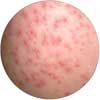Pseudomonas folliculitis and Contact Dermatitis on Groin of a 24-Year-Old Man
This 43-year-old woman presents with a painful eruption of sudden onset; it is confined to her trunk. She is otherwise healthy.What is your clinical impression?
This 43-year-old woman presents with a painful eruption of sudden onset; it is confined to her trunk. She is otherwise healthy.
What is your clinical impression?
A. Staphylococcal folliculitis.
B. Gram-negative folliculitis.
C. Pityrosporum folliculitis.
D. Acne vulgaris.
E. Follicular eczema.


(answer on next page)
Case 1: Pseudomonas folliculitis
A culture grew Pseudomonas aeruginosa, which confirmed the diagnosis of gram-negative folliculitis, B. The patient reported that she had recently started to use a hot tub.

Pseudomonas folliculitis, or hot tub folliculitis, is a community-acquired infection that results from the bacterial colonization of hair follicles after exposure to contaminated water in a contained environment (such as that found in whirlpools, swimming pools, water slides, and bathtubs).
P aeruginosa infection is usually self-limited and often clears in 2 to 10 days. Although the rash causes discomfort, no treatment is necessary. Systemic spread is typically not observed.
For patients who have persistent infections and for those who are immunosuppressed, a 1-week course of ciprofloxacin (500 or 750 mg PO bid) is recommended. Warn patients about the effects of this antibiotic on tendons.1
Staphylococcal folliculitis resembles gram-negative folliculitis and needs to be differentiated by culture. Pityrosporum folliculitis and follicular eczema also appear similar to Pseudomonas folliculitis, but these disorders are typically pruritic rather than painful. Acne vulgaris is not painful and would be unlikely to occur as an acute eruption in an adult with no history of acne.
Case 2:

This rash developed on the groin of a 24-year-old man shortly after a sexual contact. He has been with the same partner for several months. She recently changed her birth control method. Which of the following conditions do you suspect?
A. Staphylococcal folliculitis.
B. Gram-negative folliculitis.
C. Candida folliculitis.
D. Herpes simplex.
E. Contact dermatitis

(answer on next page)
Case 2: Contact dermatitis

This patient had an allergic reaction to the new spermicidal jelly used by his partner, E. Cultures showed no growth, and Gram staining did not reveal any organisms. The rash resolved with application of a topical corticosteroid cream, and the patient was told to avoid future contact with the spermicidal jelly.
The other conditions in the differential are reasonable considerations; culture is necessary to rule them out.
Case 3:

This 21-year-old college student was recently hospitalized for an asthma exacerbation, which responded to inpatient treatment. However, about 1 week after she was discharged, a mild asymptomatic rash developed on her face and to a greater extent on the upper trunk. She uses a nonsteroidal inhaled bronchodilator, a nonsedating antihistamine, and a leukotriene inhibitor that was continued from before her hospitalization.
What is the most likely diagnosis?
A. Staphylococcal folliculitis.
B. Steroid acne.
C. Pityrosporum folliculitis.
D. Pustular drug eruption.
E. Follicular eczema.

(answer on next page)
Case 3: Steroid acne

Steroid acne, B, consists of monomorphous papulopustules located predominantly on the trunk and extremities, with less involvement of the face. Characteristically, it appears after the administration of topical or systemic corticosteroids, including intravenous and inhaled therapy. This patient’s outbreak resulted from the high doses of corticosteroids she received in the hospital to treat the asthma exacerbation.
The eruption typically resolves after the corticosteroid is discontinued; in addition, the usual treatments for acne vulgaris may be effective in this setting.
Staphylococcal folliculitis is usually tender; Pityrosporum folliculitis and follicular eczema are generally pruritic. Adverse drug reactions are typically symptomatic and more widespread.
Case 4:

After returning from a skiing trip to Colorado, a 24-year-old woman seeks medical attention for this eruption of sudden onset on her lip. She also has a sore throat and low-grade fever. She is otherwise healthy, and her only medication is an oral contraceptive.
What does this look like to you?
A. Staphylococcal impetigo.
B. Candidiasis.
C. Herpes simplex.
D. Lichen planus.
E. Herpangina.
(answer on next page)
Case 4: Herpes simplex

Symptoms of primary herpes labialis, C, may include a prodrome of fever, followed by a sore throat and mouth and submandibular or cervical lymphadenopathy. In children, gingivostomatitis and odynophagia are also observed.
Painful vesicles develop on the lips, the gingiva, the palate, or the tongue and are often associated with erythema and edema. The lesions ulcerate and heal within 2 to 3 weeks.
Impetigo is characterized by honey-crusted lesions; it is much more common in children than in adults and is generally not associated with systemic symptoms. Oral candidiasis would be unlikely in an immunocompetent person, such as this patient, who is not taking antibiotics or corticosteroids. Lichen planus usually presents as a white, lacey area on the buccal mucosa and lips. The lesions associated with herpangina typically develop on the oropharyngeal structures.
References:
REFERENCE:
1.
US Food and Drug Administration. Information for healthcare professionals. Fluoroquinolone antimicrobialdrugs. July 8, 2008.
http://www.fda.gov/cder/drug/InfoSheets/HCP/fluoroquinolonesHCP.htm
. AccessedNovember 17, 2008.